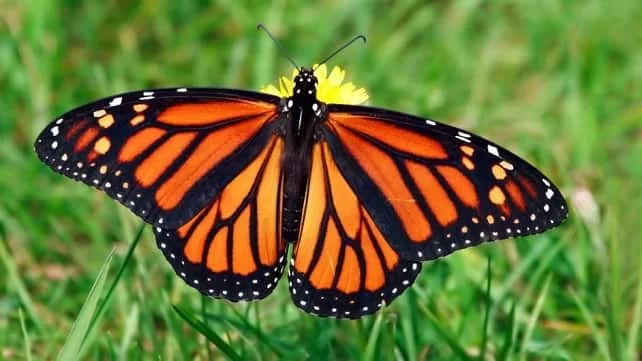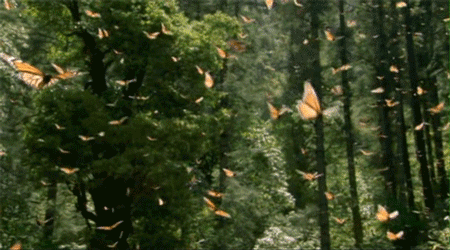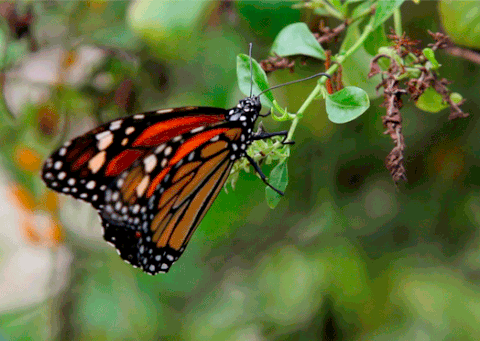
One of the first signs of fall I always look for is the movement of the Monarch Butterflies starting their fall migration. As we enter the second week of August, I have already seen several Monarchs headed towards the southwest. This is actually about two to three weeks before the migration begins in larger numbers. Monarch butterflies are the most beautiful of all butterflies, some say, and are considered the “king” of the butterflies, hence the name “monarch”.
 Monarch butterflies are not able to survive the cold winters of most of the United States so they migrate south and west each autumn to escape the cold weather. The main migration gets underway in September or even October, depending on where you live. The monarch butterflies will spend their winter hibernation in Mexico and some parts of Southern California where it is warm all year long. If the monarch lives in the Eastern states, usually east of the Rocky Mountains, it will migrate to Mexico and hibernate in oyamel fir trees. If the monarch butterfly lives west of the Rocky Mountains, then it will hibernate in and around Pacific Grove, California in eucalyptus trees.
Monarch butterflies are not able to survive the cold winters of most of the United States so they migrate south and west each autumn to escape the cold weather. The main migration gets underway in September or even October, depending on where you live. The monarch butterflies will spend their winter hibernation in Mexico and some parts of Southern California where it is warm all year long. If the monarch lives in the Eastern states, usually east of the Rocky Mountains, it will migrate to Mexico and hibernate in oyamel fir trees. If the monarch butterfly lives west of the Rocky Mountains, then it will hibernate in and around Pacific Grove, California in eucalyptus trees.
 Monarch butterflies use the very same trees each and every year when they migrate, which seems odd because they aren’t the same butterflies that were there last year. These are the new fourth generation of monarch butterflies, so how do they know which trees are the right ones to hibernate in? Monarch butterflies are the only insect that migrates to a warmer climate that is 2,500 miles away each year. The Monarch butterfly migrates for 2 reasons. They cannot withstand freezing weather in the northern and central continental climates in the winter. Also, the larval food plants do not grow in their winter overwintering sites, so the spring generation must fly back north to places where the plants are plentiful.
Monarch butterflies use the very same trees each and every year when they migrate, which seems odd because they aren’t the same butterflies that were there last year. These are the new fourth generation of monarch butterflies, so how do they know which trees are the right ones to hibernate in? Monarch butterflies are the only insect that migrates to a warmer climate that is 2,500 miles away each year. The Monarch butterfly migrates for 2 reasons. They cannot withstand freezing weather in the northern and central continental climates in the winter. Also, the larval food plants do not grow in their winter overwintering sites, so the spring generation must fly back north to places where the plants are plentiful.
 What a great sight it is to see the beautiful Monarch butterflies, “the king of butterflies” roaming around your garden and the nearby vicinity. For the people of America, the monarch butterflies have always been a part of their memorable childhood, from which they learned about pupae, larvae, metamorphosis and a score of other things related to its life cycle. But, recent studies reveal some disheartening data regarding the Monarch species. The U.S Fish and Wildlife Service disclosed recently that from the year 1990, around a billion Monarch butterflies have vanished. They alleged that the use of weed-resistant material and herbicides, is continuing to ruin their original habitat, and may well be the main reason leading to the consistent extinction of the Monarchs.
What a great sight it is to see the beautiful Monarch butterflies, “the king of butterflies” roaming around your garden and the nearby vicinity. For the people of America, the monarch butterflies have always been a part of their memorable childhood, from which they learned about pupae, larvae, metamorphosis and a score of other things related to its life cycle. But, recent studies reveal some disheartening data regarding the Monarch species. The U.S Fish and Wildlife Service disclosed recently that from the year 1990, around a billion Monarch butterflies have vanished. They alleged that the use of weed-resistant material and herbicides, is continuing to ruin their original habitat, and may well be the main reason leading to the consistent extinction of the Monarchs.
 The use of such harmful chemicals has led to the destruction of milkweed plants, the only plant on which the Monarch caterpillars feed on. This review is a proof of the massacre encountered by this lovely little creature. The extinction of Monarch butterflies is shown by the decreasing numbers reaching Mexico by way of migration, in the last two decades. Now, it has gone below the lowest recorded level of a mere 35 million. The wintering area in Mexico, Instead of spreading in the whole 45 acres like in 1996, it covers only an area of 1.7 acres by the 2013-2014 season, and that included 11 sanctuaries. The World Wildlife Fund announced this fact, and concluded that the expansion of agricultural areas has led to this disaster. In 1980, around 26 acres in the Midwest was covered with the hardy plant, milkweed, but now the grasslands of the Upper Midwest has been drastically converted into Soy Bean and Corn fields, which are cultivated using a large amount of herbicides and weed-resistant chemicals to protect their cultivation.
The use of such harmful chemicals has led to the destruction of milkweed plants, the only plant on which the Monarch caterpillars feed on. This review is a proof of the massacre encountered by this lovely little creature. The extinction of Monarch butterflies is shown by the decreasing numbers reaching Mexico by way of migration, in the last two decades. Now, it has gone below the lowest recorded level of a mere 35 million. The wintering area in Mexico, Instead of spreading in the whole 45 acres like in 1996, it covers only an area of 1.7 acres by the 2013-2014 season, and that included 11 sanctuaries. The World Wildlife Fund announced this fact, and concluded that the expansion of agricultural areas has led to this disaster. In 1980, around 26 acres in the Midwest was covered with the hardy plant, milkweed, but now the grasslands of the Upper Midwest has been drastically converted into Soy Bean and Corn fields, which are cultivated using a large amount of herbicides and weed-resistant chemicals to protect their cultivation.
 The female Monarch butterflies flutter across this area in search of a host plant to lay her eggs, little knowing that her habitat has been wiped off from this landscape, in an alarming way. By 1999, around 97% of milkweed was eradicated. Other than these areas, milkweed was also commonly found along the roadsides, edges of farms and fields, but with the regular use of herbicides, it was rooted out from all the other places as well. The good news is that nearly four times as many monarch butterflies are expected to migrate to the mountain forests of central Mexico this year as last, and that’s very good news. This population growth indicates efforts by groups like saveourmonarchs.org may be beginning to make a positive impact on their population numbers. Last year, for instance, the butterflies wintered on 2.8 acres of mountain forest, and this year it’s forecast that area will grow to between 7.4 to 10 acres. Conservationists have a goal of 15 acres by 2020.
The female Monarch butterflies flutter across this area in search of a host plant to lay her eggs, little knowing that her habitat has been wiped off from this landscape, in an alarming way. By 1999, around 97% of milkweed was eradicated. Other than these areas, milkweed was also commonly found along the roadsides, edges of farms and fields, but with the regular use of herbicides, it was rooted out from all the other places as well. The good news is that nearly four times as many monarch butterflies are expected to migrate to the mountain forests of central Mexico this year as last, and that’s very good news. This population growth indicates efforts by groups like saveourmonarchs.org may be beginning to make a positive impact on their population numbers. Last year, for instance, the butterflies wintered on 2.8 acres of mountain forest, and this year it’s forecast that area will grow to between 7.4 to 10 acres. Conservationists have a goal of 15 acres by 2020.
 On a community level, Monarch Waystations, for example, are intended to offset monarch habitat loss by growing milkweed habitats in yards and common spaces, and encourages gardeners — or anyone interested in adding milkweed to their landscape — to register with the Monarch Waystation program at the University of Kansas. Milkweed seed packets, provided by project, are available for creating a Monarch Waystation, each a new source of milkweed and other nectar sources for monarchs. The good news is that planting milkweed is one of the easiest ways that each of us can make a difference for monarchs. There are several dozen species of this wildflower native to North America, so no matter where you live, there is at least one milkweed species naturally found in your area. Planting these seeds in fall will get optimal results. I did find that you can acquire the seeds through Walmart online. A packet of 100 costs $3.65 and are shipping now. There may be other places locally to get them as well. Not only will it help the Monarch, it will also attract an array of other beneficial insects as well. Try to do your part, and save our Monarchs for future generations to enjoy these “Flowers” with wings.
On a community level, Monarch Waystations, for example, are intended to offset monarch habitat loss by growing milkweed habitats in yards and common spaces, and encourages gardeners — or anyone interested in adding milkweed to their landscape — to register with the Monarch Waystation program at the University of Kansas. Milkweed seed packets, provided by project, are available for creating a Monarch Waystation, each a new source of milkweed and other nectar sources for monarchs. The good news is that planting milkweed is one of the easiest ways that each of us can make a difference for monarchs. There are several dozen species of this wildflower native to North America, so no matter where you live, there is at least one milkweed species naturally found in your area. Planting these seeds in fall will get optimal results. I did find that you can acquire the seeds through Walmart online. A packet of 100 costs $3.65 and are shipping now. There may be other places locally to get them as well. Not only will it help the Monarch, it will also attract an array of other beneficial insects as well. Try to do your part, and save our Monarchs for future generations to enjoy these “Flowers” with wings.





